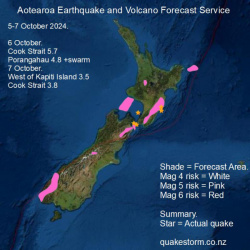Aotearoa Summary. 5 October 2024 - 7 October 2024
 |
| Click to Enlarge |
This forecast was posted without a map on Facebook on 4 October 5.03pm NZST.
A map is included in the summary, reproducing the Mag 4/5 risk locations as closely as the forecasters can.
Forecast 5-7 October 2024.
A forecast map is unavailable but local Mag 4/5 risk locations are Cook Strait, Awatere, Wairarapa, Upper Rakaia, Taumarunui, Western Taranaki Bight, Offshore East Cape, Fiordland.
Fortunately the dangerous combination of geomagnetic storming and supermoon doesn't exist during this period.
Summary.
6 October.
25km West of Wellington 5.7 5.08am
Porangahau 4.8 11.19pm +swarm
7 October.
10km West of Kapiti Island 3.5 1.22pm
25km West of Wellington 3.8 2.23pm
This forecast was unusual in that the Cook Strait 5.7 arrived just ahead of the forecasted geomagnetic storm.
The geomagnetic storm also came in two parts. The first Kp4 substorm was followed soon after by a Kp8 storm.
Solar conditions are changing in Solar Cycle 25.
Solar flares don't have the strength of Solar Cycle 24 flares...less particle speed and density.
Geomagnetic storming at Earth is sustained only by Earth's weakening magnetic field allowing magnetic flux density dropouts down to -40nanoTesla. Solar Cycle 24 was only -20nT.
Coronal hole solar wind strength has also become so weak that forecasts are hardly worth making.
The forecasters reflect on the moderate solar wind driving the 14 November 2016 Kaikoura 7.8, modulated by the biggest supermoon in 36 years and how those conditions hardly exist in 2024.
Note that coronal holes form in the places where flaring sunspots have blown away the corona. Is there a link between weak solar flares and weak coronal hole solar wind in Solar Cycle 25?
Pacific quakes follow solar wind conditions much less in Solar Cycle 25, making quake forecasting harder.
Aurora watching in New Zealand has become the new craze during Solar Cycle 25 whereas in Solar Cycle 24 auroras were only visible low on the horizon from Southland. Conditions are changing.
Historically, the last time auroras were so visible was during the Dalton Minimum Period 1790-1830 during the very weak Solar Cycles 4-7.
The period was called the Little Ice Age with wildly fluctuating weather patterns like in 2024 and increasingly cold weather observed by those many meteorologists who look harder than the headlines put up by politically appointed climate change experts.
Forecast results were ropey during this forecast period but we'll take it...
A new forecast period begins late 28 October following the 26 October X1 flare from sunspot 3873.
Cook Strait could once again become active.
Aotearoa Earthquake and Volcano Forecast Service © 2013 - 2025
|